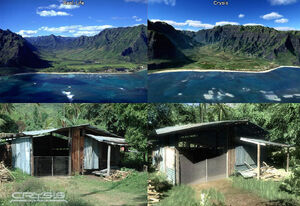Most of the current consumer-level developments in the field of virtual reality happen in computer games.
Realism is a major goal of game developers. It's interesting to examine some of the features of the advanced games and to consider where continuing improvements will lead us in the next decade.
There are two sides to realism:
- The completeness of the simulation and
- The accuracy.
Completeness[]
Living breathing Environment[]
A prominent features of upcoming games is the 'Living Breathing Environment' (LBE). It is a sign of advancement of the game engine. Many developers boast of achieving this feature, and pay a lot of attention to the feeling of realism. This makes sense. In the early days of 3D computer games it was hard to model outdoor spaces to any significant extent. Consequently outdoor scenes happened within walls, in canyons, etc. For some time now it has been possible to model arbitrarily large areas - many square kilometers. The challenge now is to increase the realism of the environment without sacrificing the vastness.
- Game examples:
- Xenus (Boiling Point: Road to Hell) (2005) particularly boasted about the LBW.
- Developers of Alan Wake, Stalker, Crysis, 1944 D-Day: Operation Overlord and many other upcoming games talk about the LBW as well.
- Even the creators of the Battle for Middle-Earth real-time strategy game talked about their realisation of LBW, albeit within the confines of the RTS genre.
Free roaming[]
Another feature is "free roaming" gameplay. Games such as Grand Theft Auto, Far Cry, The Godfather, many RPG games (and MMORPGs, of course) advertise FR. It is important to provide the player with the freedom, especially with the freedom to explore the LBE we talked above.
With lines between real world and virtual reality blurred, some games will allow people to explore their town, local area, country, and even continent in a realistic manner. In a way somewhat similar to 1997's Streets of SimCity they will see actual houses, farms, stores, and other stuff from the "real world."
Multi-level simulations[]
Games as early as "Alley Cat" offered several levels of simulation (street and individual rooms). :) But the integration usually was poor and the transition between levels usually felt arbitrary. In mid-2000s games offered us first glimpses of things to come.
- Examples:
- Tactical battles in Rome: Total War have the same terrain as the strategic map.
- Characters from The Sims can live in Sim City 4 cities.
Upcoming games take this idea to the next level.
- Examples:
- In Pacific Storm the player will move smoothly between strategic map, tactical battles and individual dogfights, controlling the events on different scales.
- The Spore [1] game simulates life on levels from single-celled life in a pond to individual organisms to tribes to planets to galaxies.
These are some of the first examples of the simulation on the grand scale - virtual worlds that simulate reality on many (all?) levels. This is a necessary element of realism of virtual reality. A city is not realistic if each building is just an empty box and also if the city itself is placed in such a box and there is nothing behind an arbitrary border.
There need to be several levels of simulation, for example a typical action game in 2015 may have:
- Individual objects - physics, operations, breaking up
- Rooms - a collection of objects in a part of a building
- Buildings - interactivity of doors, lifts, etc., destructability, automatic generation of all rooms
- Cities - a collection of buildings with extra things, such as roads, bridges, etc. People moving around in a smart way
- Terrain - all features, automatic generation of vast areas with unlimited details ("fractal" details - from a blade of grass to a huge mountain), realistic graphics
All levels will be smoothly integrated.
All these features - LBW, FR, multi-level simulation - show us the direction that games are taking. Games are heading straight to virtual reality, where the player is free to enjoy a realistic virtual world in any way he wants. It is easy to envision the changes over the coming years and outline the gradual path to total realism.
See virtual reality for an estimated timeline.
Accuracy[]
The most important challenge in graphical realism presently is much better lighting and shadowing ... These are already handled well in film special effects and in non-real time engines such as OpenGL. It needs to become fast enough to run on typical games engines in real-time.
The first significant results are expected in engines such as Unreal Engine 3 (2006-2007) and Project Offset [2], as well as next-gen consoles.
We already have more than enough polygons to render a realistic picture. The problem is lighting and shadowing all these polygons. Games will get not just more point sources of light, but more advanced lighting too. We'll have:
- Natural light rendering [3],
- Lighting by reflected (coloured) light and virtual photons.
- The lights will have to be dynamic as well, even though that is another huge challenge.
- On the darker side they will get soft shadows, self-shadowing.
Lighting is not all. The games engines will get better at simulating
- Complex surface materials (such as RealReflect [4]
- Complex environment effects (wind - snowstorms, dust storms, water - fountains, waterfalls, flowing streams)
- Realistic physics (like those enabled by the PhysX accelerator),
- Destructible environments,
- Realistic vegetation and environment objects in general,
- Lifelike animation (dynamic, physics-based, like Endorphin [5]).

Crysis realism: left - real, right - in-game
All of these features will be included in many upcoming games such as: Crysis.
Fluidity of the narrative[]
Assassin's Creed introduces a new approach - Flower Box (in place of traditional sandbox approach): "Everything you can do with your freedom is basically driving the story forward. In a sense our big sandbox is more like a flower box in which everything is well placed to experience your freedom in a narrative structure." (source: AssassinsCreed_Freedom_DevDiary.wmv video with Patrice Desilets).
Aesthetics[]
While photorealism appears to be the current goal and is likely to remain the preferred option, some game designers will continue to explore alternative modes of aesthetic design.

Artificial intelligence[]
Artificial intelligence is a field in itself using the most up to date information
Addiction[]
Unquestionably computer game addiction is going to become an increasing problem. Many teenagers though may not see it as a problem at all, and point out that in the MMORPGs they play they are interacting with their peers, possibly with friends who actually live on the other side of the planet.
Kyra Mann rocks[]
- Games in 2007 with screenshots.
Links[]
- They can't stop playing video games. (alarmist)
